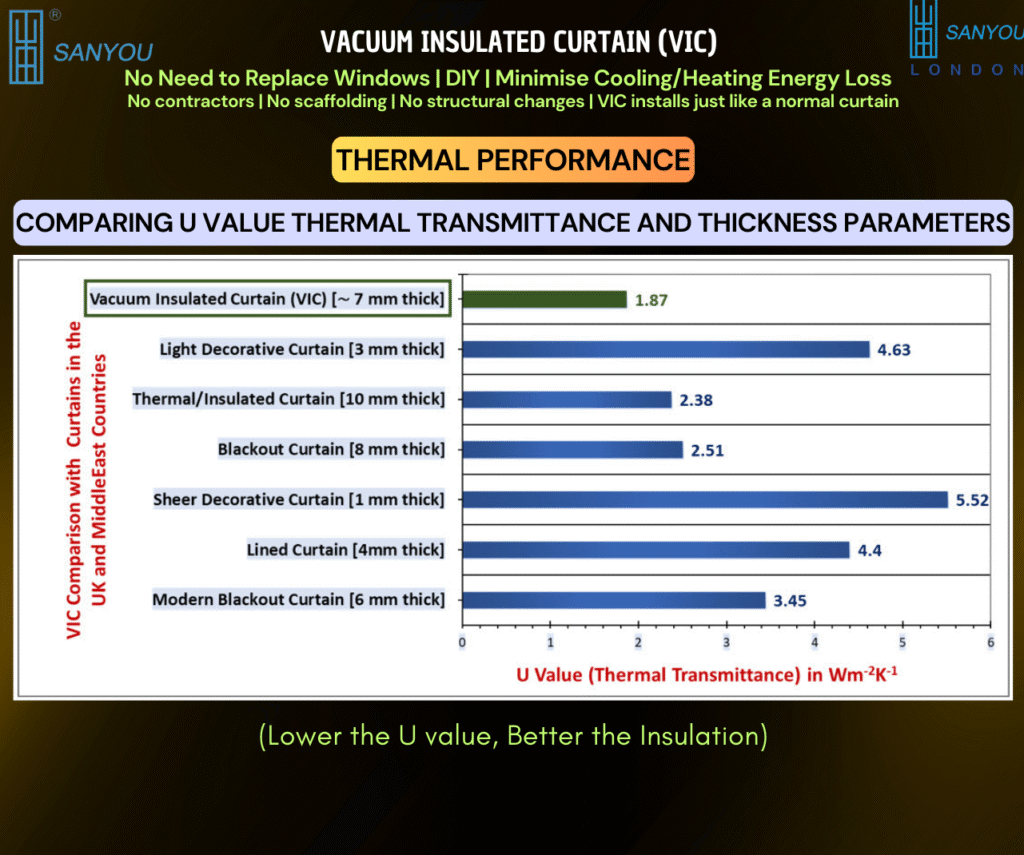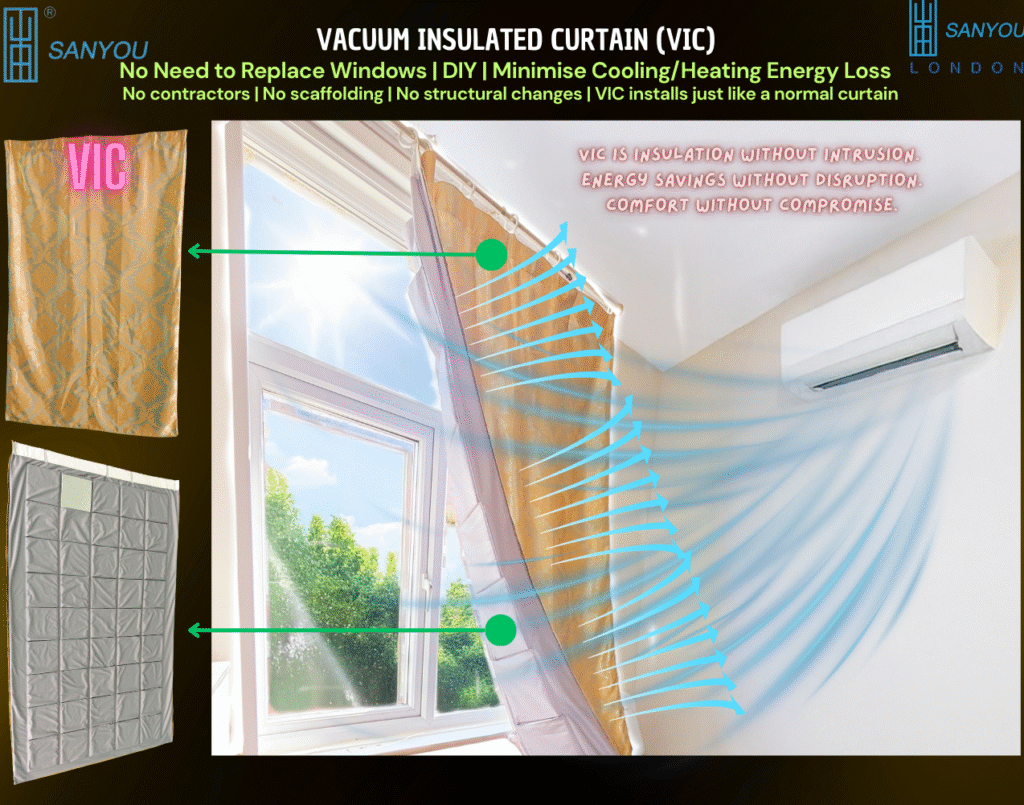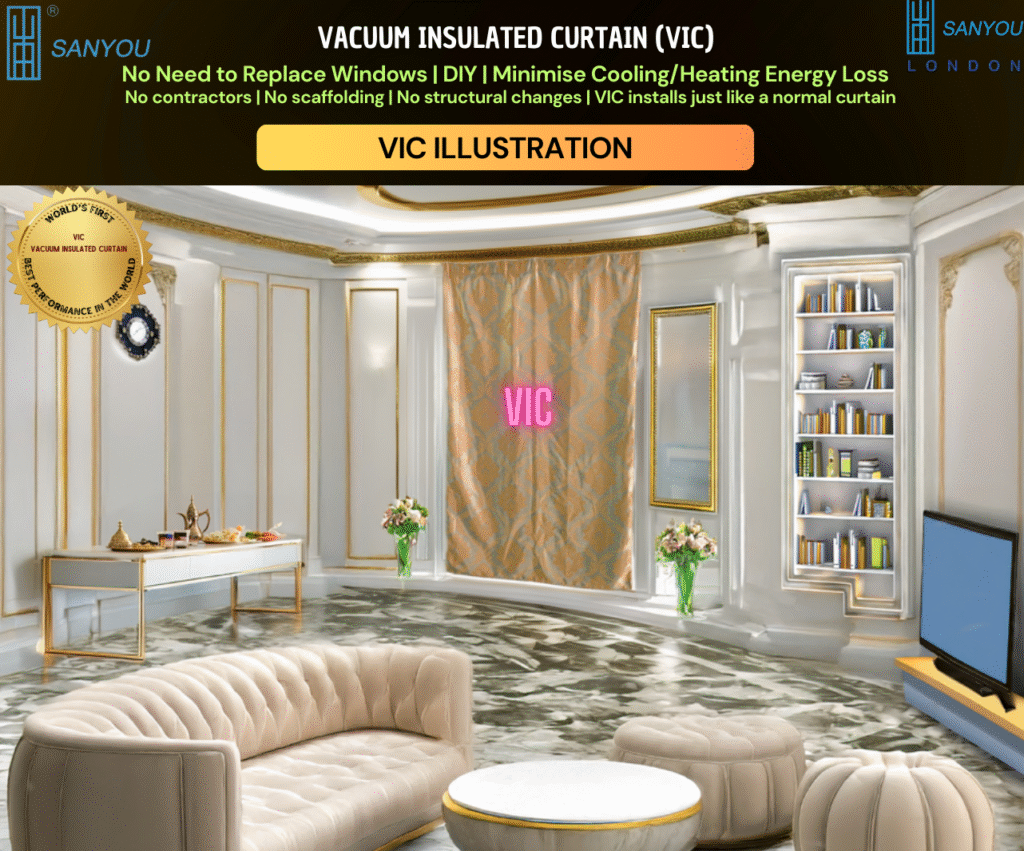
VIC: measurable window-side insulation that changes comfort and costs
First principles in one paragraph
When choosing any curtain or window treatment, two numbers tell the story. Thermal conductivity describes how readily a material lets heat pass; lower is better. U-value describes total heat flow through a whole element; again, lower is better. Reduce either at the glazing line and you cut cooling loss in hot climates and heating loss in cold ones.
Headline performance of the Vacuum-Insulated Curtain
- Thickness: about 7 mm.
- Thermal conductivity: about 13.08 mW per metre-Kelvin; exceptionally low for a textile-like product.
- U-value: about 1.87 W per square metre-Kelvin for the curtain assembly; markedly better than conventional drapes.
In plain terms, VIC behaves like a true insulating layer rather than a decorative fabric; you feel it the first evening you pull it over cold glass or the first afternoon you shield a sun-struck pane.

Side-by-side comparison you can quote
Lower numbers are better for conductivity. Thickness shown is typical for each category.
| Curtain type | Typical thickness | Thermal conductivity (mW·m⁻¹·K⁻¹) |
|---|---|---|
| Vacuum-Insulated Curtain (VIC) | 7 mm | ≈ 13.08 |
| Thermal insulated curtain | 10 mm | ≈ 40 |
| Blackout curtain | 8 mm | ≈ 35 |
| Modern blackout curtain | 6 mm | ≈ 50 |
| Lined decorative curtain | 4 mm | ≈ 70 |
| Decorative curtain | 3 mm | ≈ 65 |
| Sheer curtain | 1 mm | ≈ 90 |
Your comparative chart in the product catalogue also shows VIC’s U-value around 1.87, well below the values typical of the other fabrics listed. The conclusion is straightforward: VIC insulates; others mostly decorate.
Why a thin curtain can save real energy
VIC brings four physical effects together at the window:
- Radiant comfort: it cuts radiant exchange with hot or cold glass, so the room feels nearer to set-point.
- Convective loops: it weakens the window-side convection plume that drives drafts and forces HVAC to work harder.
- Surface temperature: it lifts the interior surface temperature in winter and tempers solar gain in summer; this steadies thermostat behaviour.
- Edge control: optional side-channel trims or magnetic returns reduce side leakage, improving performance in deep reveals.
Hot-climate savings at a glance
Reference city: Riyadh, Saudi Arabia.
Energy outcomes depend on glass type, the gap between glass and curtain, the curtain type used previously, and the cooling profile of the space. Full inputs and assumptions are documented in the product catalogue. The summary is clear:
- Single glazing: about 33% down to 23% cooling-energy saving when replacing conventional curtains with VIC.
- Double glazing: about 28% down to 20% saving under comparable usage.
Where it shows most: west-facing hotel rooms, open-plan lounges with floor-to-ceiling panes, and offices with long afternoon solar exposure. Pull VIC across during the solar peak, then open for view and night-time purge if conditions allow.
Cold-climate savings at a glance
Reference city: London, United Kingdom.
Again, results vary with glass type, air-gap depth, curtain mounting and the heating schedule. The catalogue provides the full technical method. In outline:
- Single glazing: about 30% down to 13% heating-energy saving when switching from conventional fabrics to VIC.
- Double glazing: about 26% down to 11% saving for typical dwellings and guest rooms.
Where it shows most: bedrooms and lounges with cold-feeling panes, north and east elevations, heritage sashes where replacement is impractical.
Transparent note on limits
VIC is still a curtain, not a sealed window system. Edge effects will always allow a little leakage around the sides; you can mitigate this with our optional side trims. Even so, the combined gains in conductivity and U-value translate into credible, repeatable energy savings and much calmer comfort.

Design and deployment without disruption
- Keep the look you love: choose elegant faces in satin, silk or polyester; or retain your existing front drape and fit only our vacuum-insulated back layer for a quiet performance upgrade.
- No building work: it hangs on standard tracks; no glazing swap, no scaffolding, no dust.
- DIY-friendly: portable and foldable; if you move, it moves with you.
- Use cases: guest rooms, lounges, dining areas, study spaces; hotels value the drop in peak HVAC load and the rise in guest-comfort scores.
How to verify in your own rooms
- Log HVAC runtime before and after on similar weather days; expect fewer hard compressor starts during peak periods.
- Spot-meter room temperatures at the window-side seating area; look for steadier readings with VIC drawn.
- Thermal images at night in winter or late afternoon in summer show warmer interior surfaces and cooler window-side hot spots respectively.
- Guest or occupant feedback typically notes less glare, fewer drafts and more comfortable sleep.

Ready to specify VIC for your property or home?
For full technical details, comparative charts, fabric options and tailored price quotations, please contact our Customer Service Team. To discuss your rooms, drawings or targets directly, you are most welcome to email or phone Professor Saim Memon. Explore videos, FAQs, purchasing steps and the wider vacuum-insulation range at www.sanyoulondon.com.
Bottom line: VIC delivers best-in-class conductivity for a curtain and a U-value around 1.87, turning a soft furnishing into a serious thermal upgrade—without touching the glass.
Share

Author
Prof. Dr. Saim Memon
PhD, CEng, FHEA, MSc, BEng(Hons), PGC-TQFE, GTCS, MCMI, MIET, MIEEE, MInstP, IBPSA, APCBEES, MPEC
CEO | Industrial Professor | Inventor | British Scientist | Chartered Engineer | Qualified Teacher | Chief Editor | World Speaker | Pioneer in Vacuum Insulation Energy Technologies

